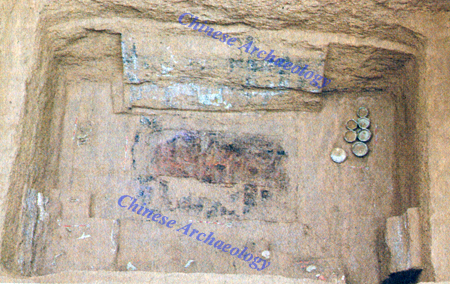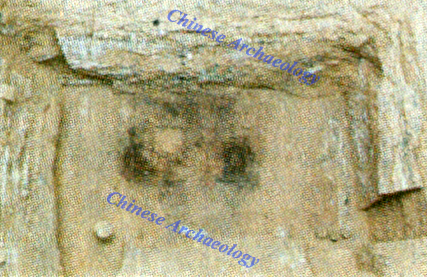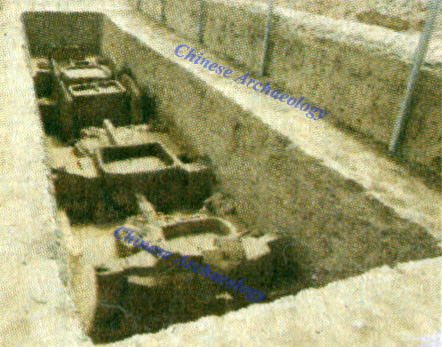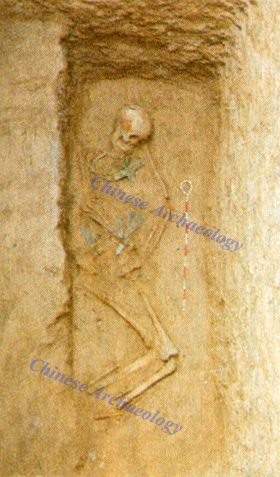Information
Qin State’s Tomb During Spring and Autumn Period Found in Shijia Cemetery, Gansu Province
Summary: Shijia cemetery located in Ning county, Gansu Province, Gansu Institute of Archaeology conducted archaeological excavation since early 2016, unearthed 8 tombs, 1 sacrificial pit, and 1 horse-chariot pit of Eastern Zhou Period till now.overall view of the
Shijia cemetery located in Ning county, Gansu Province, Gansu Institute of Archaeology conducted archaeological excavation since early 2016, unearthed 8 tombs, 1 sacrificial pit, and 1 horse-chariot pit of Eastern Zhou Period till now.

overall view of the tomb chamber (M35) of type A
The 8 tombs were all earthen shaft pit burials, presenting as rectangle shape with vertical walls. Based on the size, numbers of bronze ding tripod and coffin, the tombs could be classified into A,B,C three types.
Type A and B were noble tombs with outer-coffin and inner-coffin placed in the bottom. On the distribution and combination of the grave goods, bronze coffin ornament (sha) in fan shape appearing in pair, placing on the top of outer-coffin’s cover or in the pit’s east and west side; horse and chariot decoration, there was no certain rules of the distribution of bronze bridle, chariot axis, finials, cross fittings’ combination, and hook, most of which were placed on the top of outer-coffin’s cover or in the filled soil; chariot sacrifice was found in some tomb’s filled soil, which was only separated cart body; bronze ritual vessels (Ding tripod and Dui receptacle) and lacquer wares (box, cup with handles, plate) were placed near the north wall of the chamber; coffin ornaments, mainly pottery (stone) chime together with stone or mud shell, pottery bead, bronze bell, bronze fish etc., were placed around the coffin, and the surface of the ornaments was adhered with red lacquer, which might be the residual of the lacquer coffin cover. Bronze weapons, such as bronze dagger, spear, lacquer wooden shield, and bronze or bone arrowhead etc., were placed in some tombs’ south wall; stone or pottery gui tablet were found on the coffin cover, and jade and turquoise pieces were found under the neck and waist parts of the dead. Dog sacrifice was only appeared in the noble tombs.

overall view of the tomb chamber (M30) of type B
Taking the records in ancienct texts as references, the size, struction and offerings of these noble burials all overstep the relative regulations.
Type C tombs were common people burials, which have no coffins and without coffin decoration, bronze sha, parts of chariot and harness, and bronze ritual vessel, etc.. There were only bronze daggers and stone gui tablets around the bones.
1 sacrifice pit distributed from west to east, presented as rectangle in plane, vertical walls, and the mouth was larger than bottom. There was no coffin in the bottom of the pit without human bones. Only found a section of animal bones in the southwest, which might be the bones for oath or sacrifice.
Type C tombs were common people burials, which have no coffins and without coffin decoration, bronze sha, parts of chariot and harness, and bronze ritual vessel, etc.. There were only bronze daggers and stone gui tablets around the bones.
1 sacrifice pit distributed from west to east, presented as rectangle in plane, vertical walls, and the mouth was larger than bottom. There was no coffin in the bottom of the pit without human bones. Only found a section of animal bones in the southwest, which might be the bones for oath or sacrifice.

overall view of the chariot-horse pit MK5
One chariot-horse pit east to west headed was attached buried. The pit presented as trapezoid with tilted vertical walls, the mouth of which was larger than the bottom. The chariot and horse were in the same pit. 5 sacrificed chariots, which were all single shaft. From east to west, Chariot No. 1 was without horse, while Chariot No.2, 3, 4, and 5 were one chariot with two horses, and the horse bones were placed in the east-west pit on the both side of the chariot, while Chariot No. 2 and 3, No. 4 and 5 were closer to each other, and the horse bones were under the front cart, the horse headed towards east. There were two small pits under the horse pit with coffin cover inside, and a human sacrificed was found in each coffin. The human sacrificed in north side was in the posture of bending limbs on one side, while the south one was in the posture of bending limbs on back. Besides, there was dog sacrifice in the chariot-horse pit, which was placed under the carts.

overall view of the tomb chamber (M32) of type C
The excavated 8 tombs were all north-south headed earthen shaft pit with second-tiered platform. According to the combination and feature of grave goods as well as the ritual items as bronze sha ornament and coffin decoration, these tombs coincided with the features of Spring Autumn Periods’ tombs. Besides, the chariot and horse were buried in the same attached buried chariot-horse pit with the characteristic of whole chariot buried and east-west row arranged. While the buried chariot and harness parts such as the wei endpiece of axile and other ornament were all in cylinder shape and with coiled-serpent pattern, presenting the characteristics of Spring and Autumn Period.
On ethnicity, the characteristics of the south-north heading tombs and the combination of the grave goods belonged to Zhou people’s tomb. However, the dog sacrifice rate was relatively high in the mid-small size noble tombs; the bending limbs on side posture was popular; there were sacrificed human and dog in chariot-horse pit with whole set of chariot, and the horse and chariot remained in the riding state, which was quite different from the Zhou’s burial custom, conforming to the Qin tombs’ characteristics of Spring and Autumn Period. (Translator: Lang Langtian)
Category: English
News
Information
Key words:
